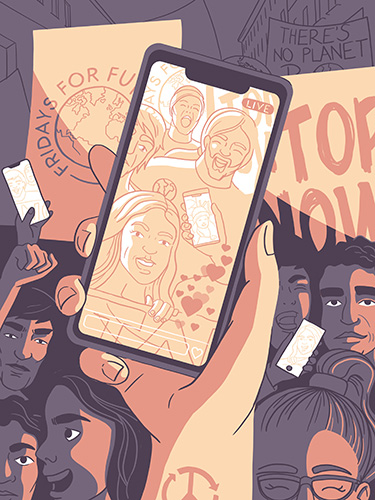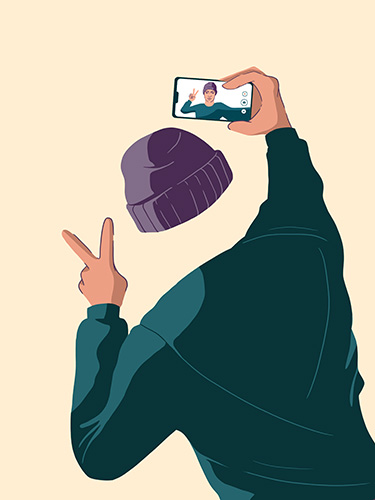The world on a screen.
Text: Noëmi Kern
A selfie with your best friend, a photo in front of the Eiffel Tower … We use our smartphones to showcase what we experience and share on social media. This affects how we perceive and present ourselves and the world around us.
What do the influencer Kim Kardashian and the absolute monarch Louis XIV have in common? The answer is that they both show their best side in images. They want other people to see what they’ve got – whether it’s power, wealth or beauty. Indeed, since humans have existed, they have presented themselves as they want to be seen. In doing so, they have also manipulated reality, because visual media influence our perception of the world.
“We use images not only to depict things but also to communicate,” says Dr. Estelle Blaschke, interim professor in the Department of Media Studies at the University of Basel, whose research focuses on topics including the history and practices of digital photography.
According to Blaschke, we’ve been living in an era dominated by images for a long time. One significant step in this development is the smartphone and its omnipresence in our pockets since around 2007. This is because smartphone displays allow us to view pictures in real time and immediately decide what to do with them. Moreover, broadband Internet means that images can immediately be sent to someone else or published on social media. Blaschke therefore describes smartphones as a tool of empowerment, because they allow everyone to produce fairly good-quality photos and videos – of ourselves, others and everything we experience, of everything that catches our eye or is interesting in some way, and of everything we find memorable or want to share. Blaschke firmly believes that this can be considered as the basis of creative processes.
Taking your own picture
The emergence of photography from the early 19th century onward has made it possible to obtain a likeness of oneself faster, more easily and more cost-efficiently than ever before. Suddenly, a broader social stratum of Westerners could afford to present and promote themselves in images in a certain way. The concept of the photographer’s studio emerged as a new business model, and poses, decor and the instructions of the photographer gave rise to certain codes and stereotypes in relation to the depiction of the self.
“Through the medium of these studio portraits, we’ve developed an ‘image’ of ourselves. Or, to put it another way, we present ourselves in photographs as we want to be seen in real life, not only in response to others but also to differentiate ourselves from them,” says Blaschke. People often made multiple copies of these images and exchanged them as a “carte de visite” (a sort of photographic calling card), thereby expanding their own network.
This underscores the social aspect of photography, which also applies to social media. After all, who doesn’t enjoy receiving likes and positive comments on photos they’ve uploaded? Platforms like these allow us to reach far more people than we could with an analog photo album or a living-room slideshow, including people outside of our own social structure.
According to Blaschke, this leads to an intensified form of pictorial narration and representation with a view to attracting attention. “Selfie culture has once again reconfigured the concept of self-representation in photos,” says the researcher. “It makes a big difference whether it is us or someone else who presses the shutter release. The option of taking a selfie means we’re acting as the content and the producer at the same time.” Indeed, Blaschke says that selfies play a role in creating a persona. She believes they provide an opportunity to contemplate the self in a playful and experimental manner by trying out different perspectives, poses, backgrounds, and combinations of images, text and reactions.
Every snapshot is a winner
Digital photography as we know it today, however, doesn’t simply depict the real world. “For years, smartphone manufacturers have been focusing on improving the camera function and incorporating presets that automatically adapt each image to a preprogrammed ideal,” says Blaschke.
What is considered “ideal” is the subject of constant renegotiation, although this process is not driven solely by users. Algorithms also favor images that generate a particularly large number of reactions and interactions. In the attention economy, whatever achieves the greatest reach wins. The algorithms therefore generate selection criteria that determine visibility, and influencers such as Kim Kardashian enjoy a corresponding level of power. “They influence the stereotypes of presentation – for example, of the female body,” says Blaschke. “In turn, these stereotypes influence the aesthetics of filter technologies. In portraits, for example, the eyes look bigger, the lips fuller, the nose smaller, the complexion healthier, and the skin clearer depending on the app or on the filter built into the imaging process.”
Moreover, simply by using functions such as “magic touch” from Google Pixel, we can witness other forms of automatic manipulation. A group of tourists walking past in the background are easily airbrushed out.
Blaschke describes this as an artificialization of the world, contrasting this concept with what she describes as aestheticization, a process whereby we design our environment to be as photogenic as possible. “The world of pictures and the real world are closely intertwined and are influenced by one another.”
The upshot of all of this is that, rather than simply depicting the world, photos to some extent present a better version of it and of ourselves, sometimes without our really noticing it. In the worst-case scenario, we like ourselves more in the optimized selfies than we do in reality.
That is not a bad thing in itself as “we don’t primarily look to social media for authenticity.” Rather, what Blaschke finds problematic is the lack of transparency and therefore the inability to control the algorithms. “We have no access to the code, and platform operators do nothing to change that – quite the contrary.” Providers are also deliberately vague about what happens with the uploaded images and the metadata associated with them. All we know for certain is that they are analyzed and utilized, and that they feed into the personalization of search results and the further development of machine vision.
Despite all of the risks, Blaschke sees certain opportunities in the capacity for easy image production thanks to smartphones and the possibilities that arise from sharing photos and videos. “There is scope for considerable diversity within the trend toward standardization. After all, media are constantly being reshaped by their users, who use them differently and in a much more diverse way than that envisaged by the technological setup.”
More articles in the current issue of UNI NOVA.


